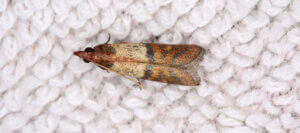WHAT DO INDIANMEAL MOTHS LOOK LIKE

The Indian meal moth is one of the most commonly reported pests of stored grains in the United States. Adult Indian meal moths are about 3/8 of an inch long and have a wingspan of about 5/8 of an inch. They have an elongated oval shaped body, their wings are gray in color except for the rear half which are a distinctive rusty bronze color. The head of the larva is dark brown in color. Moth extermination may be needed for a large infestation.
The eggs of the Indian meal moth are whitish, ovate and very small. Because of their small size, they are difficult to see without the aid of a microscope. Eggs are deposited on the grain surface singularly or in groups of twelve to thirty.
Newly hatched larvae are very small and difficult to see. Larger larvae are usually yellowish, greenish, or pinkish. Fully grown larvae are one-half to five-eights of an inch in length with a brownish head capsule. Larvae have three sets of legs near the head (thoracic legs) and five sets of prolegs on the abdomen. Larvae of the meal moth spin a web as they become fully grown and leave behind silken threads wherever they crawl. The webbing is often sufficiently abundant to attract attention. Loosely clinging webbing on the grain is characteristic of this pest. Larvae of the Indian meal moth feed upon grains, grain products, dried fruits, nuts, cereals, and a variety of processed food products. The Indian meal moth is also a common pantry pest. Adults can be seen resting on the grain surface or grain bin walls. The adults fly at night and are attracted to lights.
The eggs of the Indian meal moth are whitish, ovate and very small. Because of their small size, they are difficult to see without the aid of a microscope. Eggs are deposited on the grain surface singularly or in groups of twelve to thirty.
Newly hatched larvae are very small and difficult to see. Larger larvae are usually yellowish, greenish, or pinkish. Fully grown larvae are one-half to five-eights of an inch in length with a brownish head capsule. Larvae have three sets of legs near the head (thoracic legs) and five sets of prolegs on the abdomen. Larvae of the meal moth spin a web as they become fully grown and leave behind silken threads wherever they crawl. The webbing is often sufficiently abundant to attract attention. Loosely clinging webbing on the grain is characteristic of this pest. Larvae of the Indian meal moth feed upon grains, grain products, dried fruits, nuts, cereals, and a variety of processed food products. The Indian meal moth is also a common pantry pest. Adults can be seen resting on the grain surface or grain bin walls. The adults fly at night and are attracted to lights.